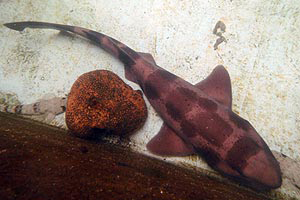Whitefin Swellshark, Cephaloscyllium albipinnum Last, Motomura & White 2008
Other Names: Whitefin Swell-shark

A Whitefin Swellhark, Cephaloscyllium albipinnum. Source: Ros Asten, Marine Education Society of Australasia. License: CC by Attribution
Summary:
A medium to large greyish to brownish swell shark with a robust body, broad dark saddles along the back and large dark blotches on the sides (distinct in juveniles), mostly dark fins with a pale margin and a uniformly pale underside, and gill slits within a large circular blotch.
When disturbed, swell sharks often increase their size by inflating their stomachs with air or water.
The Whitefin Swellshark has previously been confused with the Northern Draughtboard Shark, Cephaloscyllium variegatum, which occurs on the east coast.
When disturbed, swell sharks often increase their size by inflating their stomachs with air or water.
The Whitefin Swellshark has previously been confused with the Northern Draughtboard Shark, Cephaloscyllium variegatum, which occurs on the east coast.
Cite this page as:
Bray, D.J. 2016, Cephaloscyllium albipinnum in Fishes of Australia, accessed 03 Apr 2025, https://fishesofaustralia.net.au/home/species/2621
Whitefin Swellshark, Cephaloscyllium albipinnum Last, Motomura & White 2008
More Info
|
Distribution |
Endemic to temperate waters of southeastern Australia, from off Batemans Bay, New South Wales, to off Eucla in the Great Australian Bight, Western Australia. Found on the outer continental shelf and upper slope in depths of 125–555 m. |
|
Features |
Meristic features: Jaw teeth 62 (upper) / 66 (lower); Vertebrae 121-128 (precaudal 79-83). A large species with the following characters: head 8.6-13.5% TL in height, trunk 16.1-23.8% TL in width; origin of first dorsal-fin usually forward of mid pelvic-fin base; prenarial 4.5-5.1% TL in length; length of preorbital snout 1.4-1.7 times prenarial length, 2.5-3.1 in prepectoral length, 6.3-6.9 in pre-pelvic length; snout-vent long, its length 48.1-52.4% TL; width of nostril 2.4-2.7% TL; eye-spiracle space wide, 1.0–1.4% TL; pectoral fin large, its height 12.6-13.6% TL, posterior margin 12.0-13.6% TL in length; anal fin tall, height 3.8–4.4% TL; anal-caudal space 4.0-5.6% SL; precaudal length 74-78% TL; interdorsal space 6.3-7.6% TL; teeth with 3-5 cusps near symphysis of upper jaw; mainly weak tricuspidate flank denticles; back without greatly enlarged denticles; long adult clasper, up to 8.8% TL, almost reaching anal fin, interspace about 4.4 in anal-fin base; vertebral centra 121-126; tooth count high, each jaw with 90-116 teeth; strong pattern of saddles and blotches on upper half of body; dark, transverse dorsal markings (9-10) on body and tail, interspaces between are narrow; interspiracular saddle subequal to eye and spiracle length; over and above gill slits with large circular blotch; fins with variably developed, narrow pale margins |
|
Biology |
Swell sharks are egg layers, and females of this species lay flask-shaped egg capsules (11cm x 5cm) with no transverse ridges. Males mature by 70cm. |
|
Fisheries |
Although of little commercial value, the Whitefin Swell Shark is taken as bycatch in several fisheries, resulting in population declines. |
|
Similar Species |
The Draughtboard Shark, Cephaloscyllium laticeps, has a complex mottled pattern with blotches and spots. |
|
Etymology |
The specific name albipinnum is from the Latin albi for 'white' and pinna for 'fin', in reference to the distinctive white fin margins. |
|
Species Citation |
Cephaloscyllium albipinnum Last, Motomura & White 2008, CSIRO Mar. Atmos. Res. Pap. 022: 148, figs 1, 2, 3a. Type locality: east of Maria Island, TAS [42°38'S, 148°26'E]. |
|
Author |
Bray, D.J. 2016 |
|
Resources |
Whitefin Swellshark, Cephaloscyllium albipinnum Last, Motomura & White 2008
References
Barratt, P.J. & Kyne, P.M. 2011. Cephaloscyllium albipinnum. In: IUCN 2013. IUCN Red List of Threatened Species. Version 2013.2.
Compagno, L.J.V., Dando, M. & Fowler, S. 2005. A Field Guide to the Sharks of the World. London : Collins 368 pp. (as Cephaloscyllium sp. A)
Last, P.R., Motomura, H. & White, W.T. 2008. Cephaloscyllium albipinnum sp. nov., a new swellshark (Carcharhiniformes: Scyliorhinidae) from southeastern Australia. pp. 147-158 in Last, P.R., White, W.T. & Pogonoski, J.J. (eds) Descriptions of new Australian chondrichthyans. CSIRO Marine and Atmospheric Research Paper No. 022: 1-358.




